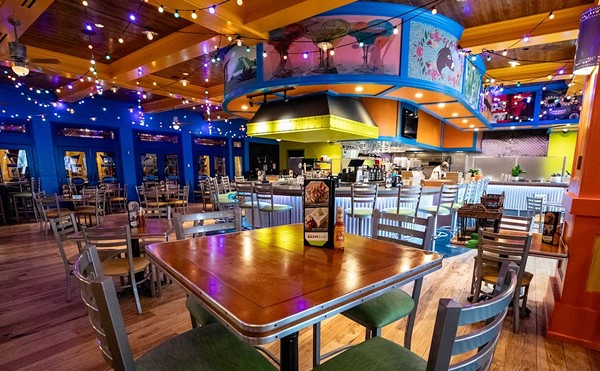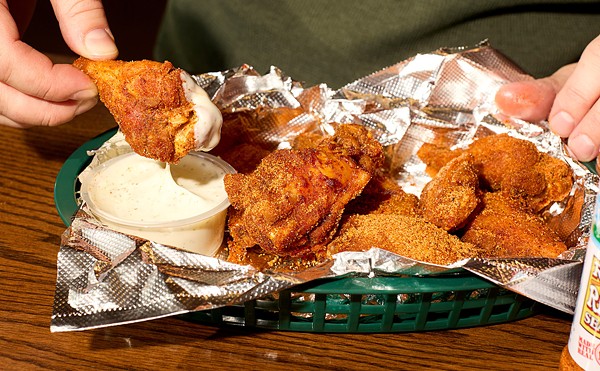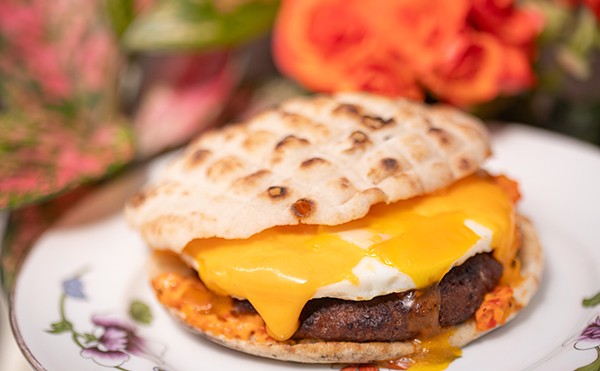Café Napoli goes these cookbooks one better. Chef Jeff Davis' entire menu -- more than a dozen pastas and nearly 25 entrées, plus antipasti and salads -- could be prepared with scarcely more ingredients than you can count on your fingers. But our visits to Café Napoli left us feeling as we do after eating a meal concocted from a three-ingredient cookbook: We wish someone had spent more time shopping.
The stock items on which the menu relies heavily are pasta, tomatoes, peppers, olives, onions, mushrooms, cream, wine, garlic, eggplant and cheeses. These are valuable staples, but they should be a starting point, not a repertoire. Little variation exists within Davis' narrowly circumscribed comfort zone. We identified button mushrooms, for instance, but no porcini, cremini or other varieties; only five or six pasta shapes of the dozens commonly used in Italy; a handful of run-of-the-mill cheeses; and so on. We missed the embroidery of Italian cuisine: sturdy greens such as kale, chard and arugula; vegetables such as squash, potatoes and leeks; dried fruits, including raisins and cherries; legumes such as fava beans, lentils and cannellini beans; a variety of nuts; and herbs and spices ranging from saffron and cumin to thyme and mint. Café Napoli's menu, in fact, is defined by what it lacks: Clinging to the skirts of a threadbare list of ingredients positions the restaurant's fare not as Italian cuisine but merely as Italian-American food.
The entrées are composed like serviceable housedresses sewn from the same pattern, varying only the neckline or the length of the hem. Most begin with a protein, such as a chicken breast or a veal chop. The dish is doused with one of several sauces such as tomato, cream or white wine, olive oil and garlic. Then such extras as capers and mushrooms are tossed in and, presto!, you have a dish. And another, and another. It's a foolproof formula for churning out prodigious quantities of food.
So why has Café Napoli packed in the customers since it opened in 1989? The main attraction is portion sizes so huge that the waiters activate backup alarms before they unload their cargo at the table. A woman can eat herself daffy and still have enough linguini left on the plate to convince her date that she has a petite appetite. But restaurants must cut corners elsewhere if they are to knock out enough veal piccata every night to feed a busload of seniors headed for Tunica. For starters, Café Napoli uses grated parmesan in place of Parmigiano-Reggiano, which food writer Jeffrey Steingarten pronounces "the only cheese whose flavor underpins an entire cuisine." No serious Italian restaurant would make such a substitution. The other cheeses listed in Café Napoli's menu descriptions are Romano, Gorgonzola, mozzarella and fontinella.
The quality of other ingredients is inconsistent. Shrimp, for example, were as big as oil drums and tasted fresh, while rings of sautéed calamari were narrower in diameter than condoms and just as rubbery. Stale, cold sesame bread arrived at the table comically swaddled in a napkin, as if to insulate it against heat loss. The uniform, commercially baked slices had the texture of a set of makeup sponges.
Part of the waiters' spiel at Napoli is to describe the specials while flourishing a dubious visual aid: A tray on which are arranged various uncooked meats, seafood and the like, each item encased in plastic and placed on spent lettuce leaves. Most bizarre of all, strips of bell pepper rest atop the plastic wrap on some specimens, as if to simulate the finished presentation. Although steak houses occasionally display cuts of meat to show off the marbling, we were puzzled as to the logic of parading raw snapper for customers' inspection. We were also discomfited by the thought that if the kitchen ran out of veal medallions or squid, the rations on the platter might be pressed into service.
Describing the dishes individually is almost superfluous, but there were minor differences among them. From the tray we selected sea scallops, a "special" that cost more than any item on the menu. The uncooked shellfish were stark white and opaque, an almost conclusive indication that they had been treated with a chemical phosphate solution to slow the rate of spoilage. These "wet" scallops, as they're called in the industry, plump up during processing, becoming heavier and thus more valuable at the market, since shellfish are sold by weight. The scallops arrived at the table with fissured surfaces that showed no sign of browning. When wet scallops are cooked, the solution leaches out and prevents the direct contact with the hot pan that allows them to pick up a nice sear.
My companion ordered veal Marsala, which seemed to have been prepared in the same light sauce that accompanied the scallops. The meals were served with house salad and our choice of the vegetable of the day or a small side of pasta. I received gummy pasta shells with a loose tomato sauce, and my companion refused to touch a dish of spinach cooked to the consistency of wet toilet paper.
On our next visit I settled on shrimp scampi, a fine rendition of a classic supper-club dish using big, barrel-chested shrimp. Linguini is over-represented at Café Napoli, making up about half of the pasta dishes on the menu. My companion chose linguini primavera, a massive tangle of al dente pasta in a white-wine sauce with a few bell peppers and other vegetables. It was inoffensive and filling but had little else to recommend it.
Antipasti offer somewhat more variety than the entrées and the pastas (in Italy, pasta is often a first course rather than an entrée). Eggplant parmigiana proved that any vegetable can be made to taste decent when paved with cheese. A tomato-and-buffalo mozzarella salad was ripe and pleasantly simple. Rashers of Nova Scotia salmon -- though just this side of turning fishy -- were as thick as skirt steak. Their heft was a welcome surprise in these days when meats, fish and even vegetables are shaved thin and fobbed off as "carpaccio."
Café Napoli's desserts are mainly purchased from local suppliers. I ordered a house-made chocolate mousse, but our waiter misunderstood and brought me a lemon ice. It perked up my palate after the leaden food. My dining partner ordered house-made crème brûlée, which masqueraded quite convincingly as instant vanilla pudding. The other desserts sounded so lackluster that, after our second visit, we paid our bill and hopscotched over to Luciano's for granitas and tawny port.





